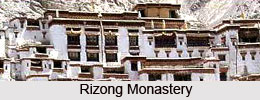 Rizong is 73km from Leh and around 6km from the main road. Rizong gompa is also called the `Yuma Changchubling` in Ladakh, India. Renowned as paradise for meditation, Rizong Monastery overlooks the Indus Valley. It is situated at the top of a rocky side valley on the north side of the Indus, to the west of Alchi on the way to Lamayuru. It was established about 138 years ago in 1831 by Lama Tsultim Nima under the Gelugkpa order. There are 40 monks in the monastery. The monastery is also called "the paradise for meditation" and is noted for its extremely strict rules and standards. The gompa belongs to the Gelugkpa order.
Rizong is 73km from Leh and around 6km from the main road. Rizong gompa is also called the `Yuma Changchubling` in Ladakh, India. Renowned as paradise for meditation, Rizong Monastery overlooks the Indus Valley. It is situated at the top of a rocky side valley on the north side of the Indus, to the west of Alchi on the way to Lamayuru. It was established about 138 years ago in 1831 by Lama Tsultim Nima under the Gelugkpa order. There are 40 monks in the monastery. The monastery is also called "the paradise for meditation" and is noted for its extremely strict rules and standards. The gompa belongs to the Gelugkpa order.
It is also believed that long ago Guru Padmasambhava meditated in the caves around Rizong years before the monasteries were built. It is also inferred that in the small caves in the vicinity, Lamas used to meditate for years in isolation from the rest of the villages. They subsisted on one meal a day, which was provided to them by local people through a 1 foot square window opening in the cave.
Lama Tsultim Nima laid down very strict rules called the "Vinaya Rules" to be followed by each monk who meditated here. Under the rules, monks cannot leave till completion of education, have to shun all material comforts and forsake all material possessions. So strict are the rules that the monks are even forbidden to light fire in their cells and can"t touch anything which has been handled by women.
The monastery has three main chambers; two chambers have statues of Buddha and the third one has stupas. In addition, there are several shrines in the monastery complex. Dukhang, the assembly hall, has statues of Sakyamuni Buddha and other Buddhist deities. The monastery also oversees the functioning of a nunnery located about two km away. The Julichen nunnery houses 26 nuns who take full participation in the economic activity of the monastery. The nuns spend their lives spinning wool, milking, extracting oils from the seeds and helping in harvest of agricultural produce. Rizong is the only monastery in Ladakh where mask or cham dances are not performed as per the Vinaya rules.
There is a relic shrine which is called as Sku-Gdung which shows old remnants of the monastery at the center. Then there is an assembly hall having statue of Sakyamuni Buddha in the center. It contains wall paintings of Dlama-mchod-pa and Lam-rims. Holy books or bibles of Bka-gyurand and bstan-gyur were assembled on the sides. The central throne is reserved for the founder with the side seats earmarked for Sras Rinpoche and mKhan-po of the monastery.
In the Rizong monastery, there is a sacred chamber having statue of Mahakala who was the originator of the monastery and a sculpture of second incarnate are positioned. Each of the rows of this chamber has the idols of the two head lamas. Mandala shrine is the roof over the assembly which is known for Mandala of Lord Yamakantaka. It also has the distinction of having two lamas incarnates.



















